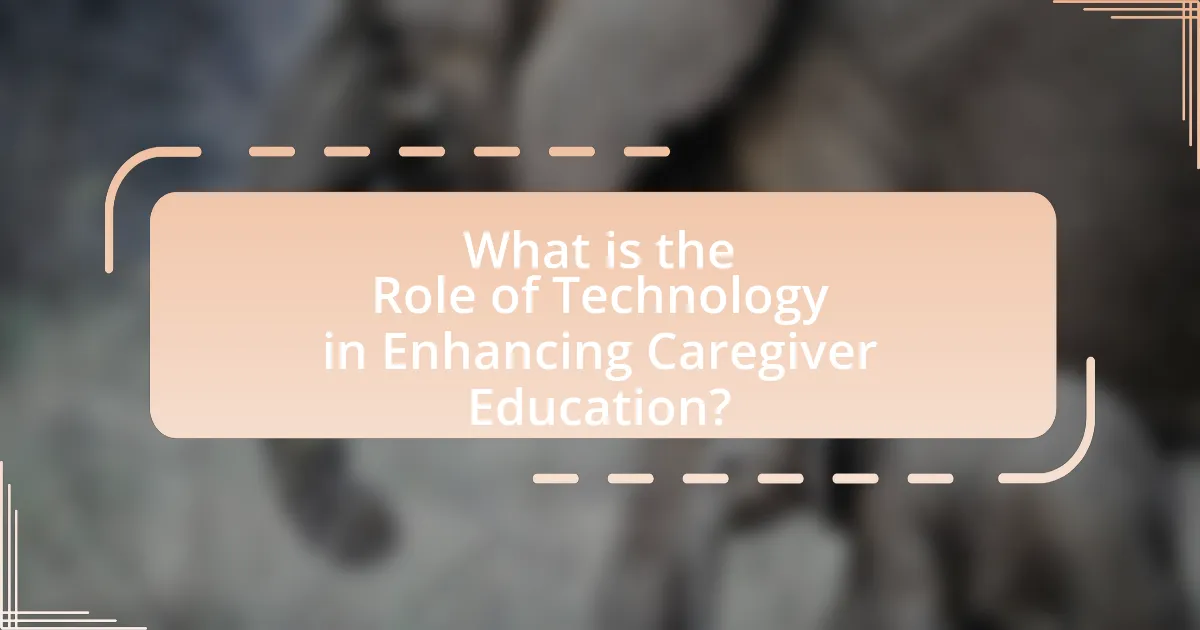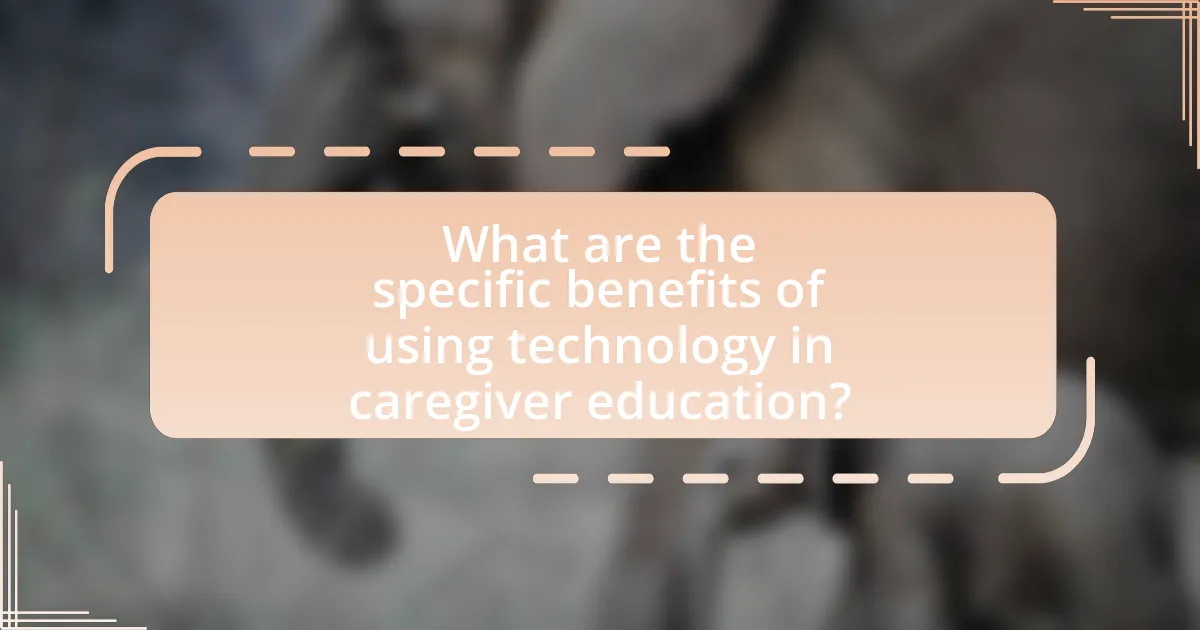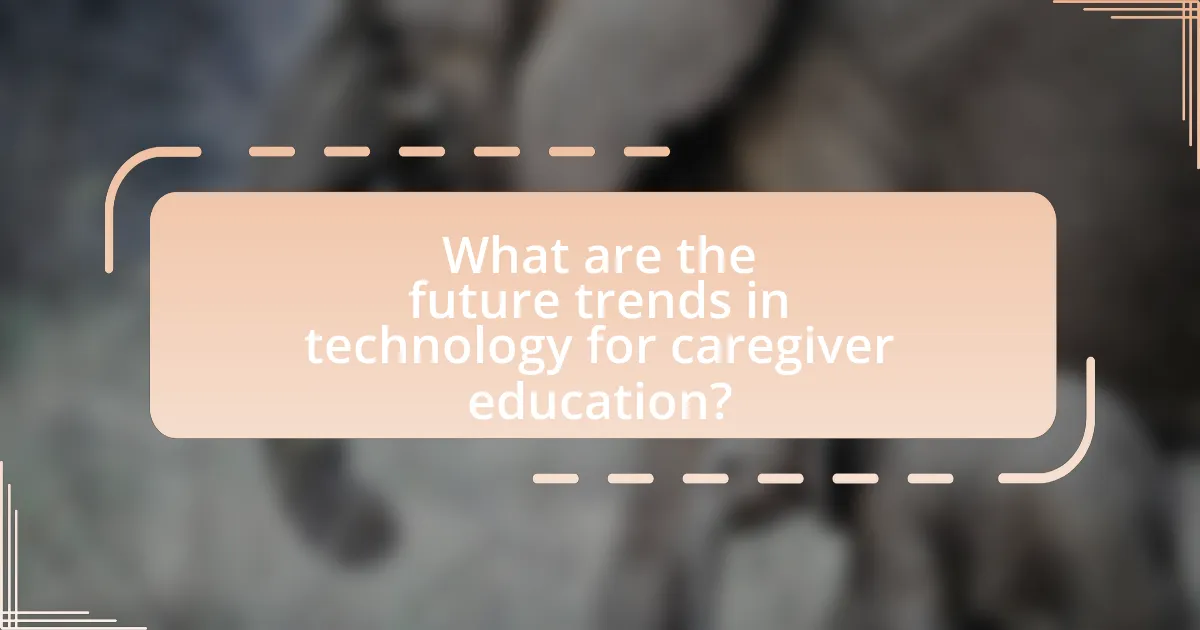The article focuses on the role of technology in enhancing caregiver education, highlighting how digital tools such as online training platforms, mobile applications, and virtual simulations improve accessibility, engagement, and learning outcomes for caregivers. It discusses the benefits of technology integration, including personalized learning experiences and ongoing support, while addressing challenges faced by traditional education methods. Additionally, the article explores future trends in caregiver training, such as the use of artificial intelligence and virtual reality, and outlines best practices for implementing technology effectively in caregiver education.

What is the Role of Technology in Enhancing Caregiver Education?
Technology plays a crucial role in enhancing caregiver education by providing accessible, interactive, and personalized learning experiences. Online training platforms, mobile applications, and virtual simulations enable caregivers to acquire essential skills and knowledge at their own pace, which is particularly beneficial given the diverse backgrounds and schedules of caregivers. For instance, a study published in the Journal of Medical Internet Research found that e-learning modules significantly improved caregivers’ competencies and confidence in managing patient care. Additionally, technology facilitates ongoing education through webinars and online resources, ensuring caregivers stay updated with the latest practices and guidelines in healthcare.
How does technology influence caregiver training and development?
Technology significantly enhances caregiver training and development by providing accessible, interactive, and personalized learning experiences. Online platforms and mobile applications facilitate flexible training schedules, allowing caregivers to learn at their own pace, which is crucial given the demanding nature of their work. For instance, virtual simulations and e-learning modules enable caregivers to practice skills in a safe environment, improving their confidence and competence. Research from the Journal of Medical Internet Research indicates that technology-based training can lead to better retention of information and improved performance in real-world scenarios. Additionally, telehealth tools allow caregivers to receive ongoing support and guidance from healthcare professionals, further enhancing their skills and knowledge.
What types of technology are commonly used in caregiver education?
Commonly used technologies in caregiver education include online training platforms, mobile applications, virtual reality simulations, and telehealth services. Online training platforms, such as Coursera and Udemy, provide accessible courses that cover essential caregiving skills and knowledge. Mobile applications, like CareZone and MyTherapy, assist caregivers in managing medications and tracking health information. Virtual reality simulations offer immersive experiences for caregivers to practice skills in realistic scenarios, enhancing their learning. Telehealth services enable caregivers to consult with healthcare professionals remotely, ensuring they receive guidance and support as needed. These technologies collectively enhance the effectiveness and accessibility of caregiver education.
How do these technologies improve learning outcomes for caregivers?
Technologies improve learning outcomes for caregivers by providing interactive and personalized educational experiences. These tools, such as online training platforms and mobile applications, facilitate access to up-to-date information and resources tailored to individual learning needs. For instance, a study published in the Journal of Medical Internet Research found that caregivers using mobile health applications reported a 30% increase in knowledge retention compared to traditional training methods. This evidence demonstrates that technology enhances engagement and effectiveness in caregiver education, leading to better care practices and improved patient outcomes.
Why is technology integration important in caregiver education?
Technology integration is important in caregiver education because it enhances learning efficiency and accessibility. By utilizing digital tools, caregivers can access a wealth of resources, including online training modules, virtual simulations, and real-time communication platforms, which facilitate immediate feedback and support. Research indicates that technology-enhanced learning environments improve knowledge retention and skill application, as evidenced by a study published in the Journal of Nursing Education, which found that 85% of participants reported increased confidence in their caregiving skills after engaging with technology-based training. This integration ultimately leads to better patient outcomes and more effective caregiving practices.
What challenges do traditional caregiver education methods face?
Traditional caregiver education methods face several challenges, including limited accessibility, outdated content, and a lack of engagement. Limited accessibility arises from geographical barriers and the inability of some caregivers to attend in-person training sessions, which can hinder their ability to receive essential education. Outdated content is another significant issue, as many traditional programs do not incorporate the latest research or best practices in caregiving, leading to a knowledge gap. Additionally, a lack of engagement in traditional methods often results from passive learning environments that do not cater to diverse learning styles, making it difficult for caregivers to retain information effectively. These challenges highlight the need for innovative approaches, such as technology-enhanced education, to improve caregiver training and support.
How does technology address these challenges?
Technology addresses challenges in caregiver education by providing accessible training resources and interactive learning platforms. Online courses and mobile applications enable caregivers to learn at their own pace, overcoming geographical and time constraints. For instance, a study by the Pew Research Center found that 73% of caregivers use online resources to enhance their skills, demonstrating the effectiveness of technology in facilitating education. Additionally, virtual simulations and telehealth tools allow caregivers to practice skills in realistic scenarios, improving their confidence and competence in real-world situations.

What are the specific benefits of using technology in caregiver education?
The specific benefits of using technology in caregiver education include improved accessibility, enhanced learning experiences, and increased efficiency in training. Technology allows caregivers to access educational resources anytime and anywhere, which is crucial for those balancing work and personal commitments. Additionally, interactive tools such as simulations and online courses provide engaging learning experiences that can lead to better retention of information. Studies have shown that technology-enhanced training can reduce the time required for caregivers to become proficient in their roles, thereby increasing the overall efficiency of caregiver education programs.
How does technology enhance accessibility for caregiver training?
Technology enhances accessibility for caregiver training by providing online platforms and resources that allow caregivers to access training materials anytime and anywhere. These digital tools, such as e-learning modules, webinars, and mobile applications, enable caregivers to learn at their own pace and fit training into their schedules. For instance, a study published in the Journal of Medical Internet Research found that online training programs significantly increased participation rates among caregivers, demonstrating that technology effectively removes geographical and time barriers to education.
What platforms provide online training for caregivers?
Several platforms provide online training for caregivers, including CareAcademy, Relias, and Coursera. CareAcademy offers a comprehensive curriculum specifically designed for caregivers, focusing on essential skills and compliance training. Relias provides a wide range of courses tailored to various caregiving settings, ensuring that caregivers meet industry standards. Coursera partners with universities to offer courses that cover caregiving fundamentals and specialized topics, enhancing the educational resources available to caregivers. These platforms are recognized for their quality content and accessibility, making them valuable resources for caregiver education.
How do mobile applications support caregiver education?
Mobile applications support caregiver education by providing accessible resources, training modules, and real-time communication tools. These applications enable caregivers to access educational materials, such as videos and articles, at their convenience, which enhances their knowledge and skills. For instance, a study published in the Journal of Medical Internet Research found that mobile health applications significantly improved caregivers’ understanding of patient care practices, leading to better outcomes. Additionally, features like reminders and alerts help caregivers manage their responsibilities effectively, reinforcing learning through practical application.
What role does technology play in ongoing caregiver support and resources?
Technology plays a crucial role in ongoing caregiver support and resources by providing tools that enhance communication, access to information, and training opportunities. For instance, telehealth platforms enable caregivers to consult healthcare professionals remotely, ensuring they receive timely advice and support. Additionally, mobile applications offer resources such as medication reminders and care management tools, which help caregivers organize and track care tasks effectively. Research indicates that 70% of caregivers report that technology improves their ability to manage care responsibilities, highlighting its significance in reducing caregiver stress and enhancing the quality of care provided.
How can technology facilitate peer support among caregivers?
Technology can facilitate peer support among caregivers by providing platforms for communication, resource sharing, and emotional support. Online forums, social media groups, and dedicated apps enable caregivers to connect, share experiences, and access valuable information. For instance, a study published in the Journal of Medical Internet Research found that caregivers who participated in online support groups reported reduced feelings of isolation and increased access to helpful resources. These digital tools create a sense of community, allowing caregivers to exchange advice and encouragement, ultimately enhancing their caregiving experience.
What resources are available online for continuous caregiver education?
Online resources for continuous caregiver education include platforms such as Coursera, which offers courses on caregiving and health management, and the Family Caregiver Alliance, providing webinars and articles tailored for caregivers. Additionally, the National Alliance for Caregiving offers online training modules and resources. These platforms are validated by their partnerships with healthcare organizations and educational institutions, ensuring that the information is credible and relevant to current caregiving practices.

What are the future trends in technology for caregiver education?
Future trends in technology for caregiver education include the increased use of virtual reality (VR) and augmented reality (AR) for immersive training experiences. These technologies allow caregivers to practice skills in realistic scenarios, enhancing their learning and retention. For instance, a study by the University of Southern California found that VR training improved the confidence and competence of caregivers in handling complex patient interactions. Additionally, artificial intelligence (AI) is being integrated into educational platforms to provide personalized learning experiences, adapting content to the individual needs of caregivers. This trend is supported by research from the Journal of Medical Internet Research, which highlights that AI-driven platforms can significantly improve knowledge retention and application in real-world settings. Furthermore, mobile applications are becoming increasingly popular, offering on-the-go access to training materials and resources, which aligns with the growing demand for flexible learning solutions in the caregiving field.
How is artificial intelligence shaping caregiver training programs?
Artificial intelligence is significantly shaping caregiver training programs by personalizing learning experiences and enhancing skill development. AI-driven platforms analyze individual learner data to tailor training modules, ensuring that caregivers receive instruction that aligns with their specific needs and learning paces. For instance, a study by the National Center for Biotechnology Information highlights that AI can adapt training content based on real-time assessments of caregiver performance, leading to improved retention of critical caregiving skills. Additionally, AI simulations provide realistic scenarios for caregivers to practice their skills, which has been shown to increase confidence and competence in real-world situations.
What potential does virtual reality hold for immersive caregiver education?
Virtual reality holds significant potential for immersive caregiver education by providing realistic, interactive training environments that enhance learning outcomes. This technology allows caregivers to practice skills in simulated scenarios, such as managing patient interactions or emergency situations, without the risks associated with real-life practice. Research indicates that immersive simulations can improve knowledge retention and skill acquisition; for instance, a study published in the Journal of Medical Internet Research found that VR training led to a 30% increase in procedural knowledge among healthcare professionals. By engaging learners in a controlled, yet lifelike setting, virtual reality can effectively bridge the gap between theoretical knowledge and practical application in caregiver education.
How can data analytics improve caregiver training effectiveness?
Data analytics can improve caregiver training effectiveness by providing insights into training outcomes and identifying areas for improvement. By analyzing data from training assessments, caregiver performance metrics, and feedback surveys, organizations can tailor training programs to address specific skill gaps and enhance learning experiences. For instance, a study published in the Journal of Nursing Education found that data-driven approaches led to a 25% increase in knowledge retention among caregivers, demonstrating the impact of targeted training interventions based on analytics. This evidence supports the notion that leveraging data analytics can lead to more effective and efficient caregiver training programs.
What best practices should be followed when implementing technology in caregiver education?
Best practices for implementing technology in caregiver education include ensuring user-friendly interfaces, providing comprehensive training, and integrating interactive elements. User-friendly interfaces facilitate ease of access and engagement, which is crucial for caregivers who may have varying levels of technological proficiency. Comprehensive training ensures that caregivers are comfortable and competent in using the technology, which can lead to better educational outcomes. Integrating interactive elements, such as simulations or quizzes, enhances learning retention and application of knowledge. Research indicates that interactive learning can improve retention rates by up to 75%, demonstrating the effectiveness of these practices in enhancing caregiver education.
How can organizations ensure technology is user-friendly for caregivers?
Organizations can ensure technology is user-friendly for caregivers by involving them in the design and testing phases of technology development. Engaging caregivers in user experience research allows organizations to gather direct feedback on their needs and preferences, leading to more intuitive interfaces. For instance, studies show that user-centered design approaches can improve usability by up to 50%, making technology more accessible and effective for caregivers. Additionally, providing comprehensive training and ongoing support can further enhance user-friendliness, ensuring caregivers feel confident and competent in using the technology.
What strategies can enhance engagement in technology-based training?
Interactive elements, such as quizzes and simulations, can significantly enhance engagement in technology-based training. These strategies actively involve learners, making the training experience more immersive and effective. Research indicates that incorporating interactive components can increase retention rates by up to 75%, as learners are more likely to remember information when they actively participate in the learning process. Additionally, personalized learning paths that adapt to individual progress and preferences can further boost engagement, as they cater to the unique needs of each learner, leading to a more tailored and relevant educational experience.